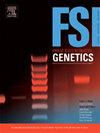A septennium review of wildlife forensic DNA analysis in South Africa
IF 3.1
2区 医学
Q2 GENETICS & HEREDITY
引用次数: 0
Abstract
The application of scientific research tools and technologies in wildlife forensic analysis is fundamental to support law enforcement in the regulation and enforcement of illegal criminal activities. Validated genetic technologies and techniques have proven to be critical in securing successful prosecutions specifically through the examination of DNA from physical exhibit material. In South Africa, DNA techniques and tools have been implemented to identify and characterise biological evidence of wildlife, in answering questions that arise during crime investigation and prosecution. Here, we describe, and review wildlife forensic cases analysed in South Africa (by South African National Biodiversity Institute (SANBI) and the Veterinary Genetic Laboratory (VGL)) over a seven-year period (August 2017 to July 2024). In total, 3 763 wildlife forensic cases were analysed. The taxonomic representation was skewed towards mammals encompassing 94.1 % of all cases due to large amount of wildlife cases involving black and white rhinoceros, African elephant, lion and antelope. These cases were predominantly from the north-eastern parts of the country including Limpopo, Mpumalanga and KwaZulu-Natal provinces which have previously been classified as a ‘hotspot’ for poaching. The type of analysis requested varied between the different taxonomic groups with 90 % of mammal cases submitted for DNA comparison, while bird, reptile, fish and invertebrate cases were mainly submitted for species identification (>87 %). This paper further reviews the successes and challenges encountered from a South African perspective and provides future recommendations.
南非野生动物法医DNA分析的九十年回顾
在野生动物法医分析中应用科学研究工具和技术对于支持执法部门监管和执法非法犯罪活动至关重要。经过验证的遗传技术和技术已被证明是确保成功起诉的关键,特别是通过检查物证材料中的DNA。在南非,已经实施了DNA技术和工具来识别和描述野生动物的生物证据,以回答犯罪调查和起诉期间出现的问题。在这里,我们描述并回顾了南非(由南非国家生物多样性研究所(SANBI)和兽医遗传实验室(VGL))在七年期间(2017年8月至2024年7月)分析的野生动物法医案例。共分析了3 763宗野生动物法证个案。由于大量的野生动物病例涉及黑、白犀牛、非洲象、狮子和羚羊,因此分类代表性偏向于哺乳动物,占所有病例的94.1% %。这些案件主要发生在该国东北部,包括林波波省、姆普马兰加省和夸祖鲁-纳塔尔省,这些省以前被列为偷猎的“热点”。不同分类类群所要求的分析类型不同,哺乳动物的90 %用于DNA比较,而鸟类、爬行动物、鱼类和无脊椎动物的DNA鉴定主要用于物种鉴定(>87 %)。本文从南非的角度进一步回顾了成功和遇到的挑战,并提出了未来的建议。
本文章由计算机程序翻译,如有差异,请以英文原文为准。
求助全文
约1分钟内获得全文
求助全文
来源期刊
CiteScore
7.50
自引率
32.30%
发文量
132
审稿时长
11.3 weeks
期刊介绍:
Forensic Science International: Genetics is the premier journal in the field of Forensic Genetics. This branch of Forensic Science can be defined as the application of genetics to human and non-human material (in the sense of a science with the purpose of studying inherited characteristics for the analysis of inter- and intra-specific variations in populations) for the resolution of legal conflicts.
The scope of the journal includes:
Forensic applications of human polymorphism.
Testing of paternity and other family relationships, immigration cases, typing of biological stains and tissues from criminal casework, identification of human remains by DNA testing methodologies.
Description of human polymorphisms of forensic interest, with special interest in DNA polymorphisms.
Autosomal DNA polymorphisms, mini- and microsatellites (or short tandem repeats, STRs), single nucleotide polymorphisms (SNPs), X and Y chromosome polymorphisms, mtDNA polymorphisms, and any other type of DNA variation with potential forensic applications.
Non-human DNA polymorphisms for crime scene investigation.
Population genetics of human polymorphisms of forensic interest.
Population data, especially from DNA polymorphisms of interest for the solution of forensic problems.
DNA typing methodologies and strategies.
Biostatistical methods in forensic genetics.
Evaluation of DNA evidence in forensic problems (such as paternity or immigration cases, criminal casework, identification), classical and new statistical approaches.
Standards in forensic genetics.
Recommendations of regulatory bodies concerning methods, markers, interpretation or strategies or proposals for procedural or technical standards.
Quality control.
Quality control and quality assurance strategies, proficiency testing for DNA typing methodologies.
Criminal DNA databases.
Technical, legal and statistical issues.
General ethical and legal issues related to forensic genetics.

 求助内容:
求助内容: 应助结果提醒方式:
应助结果提醒方式:


